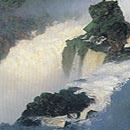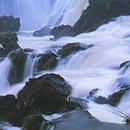The Iguazú WaterfallsThe biggest and the prettiest of all
The Iguazu Waterfalls are no doubt one of the world's natural wonders. Declared Heritage of Mankind, they make up a series of 275 jumps scattered over a pair of amphitheaters that fall from a height of 80 yards down a slope that stretches out for almost three miles long. The waterfalls belong to two countries –Argentina and Brazil- as the borderline verges on the breathtaking Devil's Throat.
Iguazu moves approximately 1,700 cubic meters of water per second with a thundering noise that can be heard from miles away. The beauty of the water takes the colors of a rainbow that comes on and off all the time in different shades and hues.
The Brazilian Side
Many people believe the Iguazu Waterfalls lie exclusively on Brazilian soil since this is the one country that pours bigger efforts into their promotion overseas. However, most of the jumps are spotted on the Argentine side. Indeed, you have to take a look at both sides of the waterfalls and find out that each one offers a different and gorgeously beautiful view.
I arrived in the Brazilian town of Foz de Iguazu, some 17 miles from the waterfalls. It was July and temps were pretty mild. The town is blessed with a great assortment of hotels of all stripes and categories.
It's really easy and el cheapo to approach the waterfalls as long as you get on one of the local buses with scheduled departures every top of the hour. With my payload of photographic equipment and some pick-me-ups, I spent the whole day at the very base of the Devil's Throat, where most of the water falls off.
The Brazilian side offers a better panoramic view over a group of jumps. Moreover, a fleet of choppers take off right there –something environmentalists stand against- and charge $70 apiece for a complete overhead tour of all the trails leading to the watchtowers. The copters even pancake quite near the water surface. The whole flight does not exceed eight minutes as you fly over that white-foam wonder. Scores of day-trippers come to the waterfalls everyday –a considerable chunk of them hailing from other Brazilian tourist circuits- and stay there for a few hours or an entire day. But there are no signs of massive tourist turnouts because the thumping noise is so thunderous and the surrounding view is so spectacular, that people get stunned out of sheer contemplation. In Iguazu, visitors lose the notion that man is the gauge of everything.
I wanted to take a snapshot that could convey the sensation of breast-milk concentration produced by the frenzied movement of the water. So, I waited until sunset as I enjoyed the beautiful solitude of the day's last sunrays plucking some haze off the waterfalls. I shuffled along the wet rocks as I snuck up to the base of the falls. I myself was already soaking wet by thousands of tiny drops. I set up the tripod as good as it could stand and took a few shots at different speeds.
I was right under the Devil's Throat, but I'd rather rename it God's Navel for I got an impression as if I were inside a cosmic generator. The view gets even more jaw-dropping as the night closes in. The foam and the pulverized water crush harder against the basaltic black rocks and the water seems to roar even louder, leaving no room for nightly silence.
The Argentine Side
The next day, I hopped in a bus that drove me to the Argentine side. In both countries, the area has been declared natural parks. That means visitors must comply with certain regulations and walk down the well-blazed trails. These trails, even though they are all beaten tracks, are not to be overlooked for the sake of environmental preservation.
There's a vast subtropical jungle there that escaped from the ruthless claws of felling thanks to the economic interest generated by tourism.
Among the activities scheduled on the premises, I enrolled myself in a jeep ride across the jungle –quite a chance to gaze at a huge diversity of plants and wildlife. We see orchids, palmettos and amazingly tall trees as the guides explain very interesting things about them. As to animal life, that depends on a surprise factor. An abundance of birds, like toucans and parrots, fly over the top of the trees, like the majestic rosewood that reaches 40 yards high and sports a 30-meter diameter. I also was lucky enough to steal a glimpse at a jaguar.
We then headed to the wharf. Using motor-equipped boats, we sail past the Island of San Martin and the astonishing fall named after the islet. Another Zodiac boat took us closer to the restless waters. The skipper's experience allows us to gauge the right distance and avoid any chances. However, the emotion is in the bag.
Strolling Around The Waterfalls
I remain in the Argentine side and later in the afternoon I took the so-called Upper Circuit that leads to the edge of the Devil's Throat. The river seems to be standing still, but the suddenly steep slope makes its waters go up in thick clouds of steam.
In order to reach this and other watchtowers in a safe way, the trails are outfitted with handrails, bridges and platforms right at the pit's brink to let you take a closer look at the waterfalls. Visitors are suggested to wear watertight and firm shoes to walk on such a slippery surface.
The night closes in and the golden-hued shade of light tells me time has come to stare at this spectacular fall. All of a sudden, I start thinking of some movie scenes.
Where have I seen this before? I got it! The Mission, a movie with that heart-wrenching scene in which a crucified Robert De Niro is tossed into his death to the bottom of the waters. But no matter how many scenes like that we've ever seen at the movies before. You bet the very first look at the waterfalls will go beyond your wildest expectations.
Beyond the Big Water
When the Iguazu River –coming down from the jungle-like Brazilian plains- falls over these larger-than-life waterfalls, there are still 20 miles spanning between the falls and the Grand Parana. At the mouth of this river, the Argentine, Brazilian and Paraguayan borders convene.
The three emblematic towns in each country offer what they've got, or what they can give. Crossing the Bridge of Friendship, you hit upon Paraguay's Ciudad del Este, the main commercial hub selling duty-free items from everywhere else under the sun –electronic gadgets, foodstuffs, liquors and perfumes. For its neighboring nations, the place stands for a shopping attraction. In a word, a motley and sometimes chaotically bizarre public square.
A little farther to the south, you find Argentina and Puerto Iguazu, the capital of the province of Misiones. This city has gone for wool and leather craftsmanship, let alone tax deductions on almost every item on sale.
In Foz de Iguazu (Brazil), there's an interesting mineral trade. Particularly abundant, those semiprecious gems that can be wrought by hand and tools.
I'm off and there's still just another surprise in the offing. The pilot flies in circles over the breathtaking waterfalls. The best look appears to be on the right side of the chopper, so it's worth asking and taking home that final visual keepsake.
Three borderlines convene in Iguazu: Brazil, Argentina and Paraguay. Three cultures blend and complement one another forming a beautiful tourist compound.
The waterfalls are like a nonstop flow of energy. There are zillions of perspectives and checkpoints to gaze at this natural spectacle.
Iguazu is a standstill river until it gets to the waterfalls. The thumping noise of the 1,700 cubic meters falling at every second, trumpets the upcoming showdown.






































































